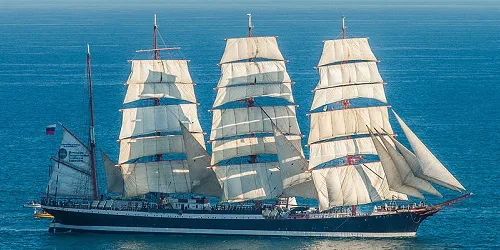-
Cruise Line InformationCarnival Cruise Line Cruising Guide & Tips Alcohol Prices & Selections Unlimited Soda Program Cheers! Beverage Program Deck Plans Dry Dock Schedule Menus Food Recipes Beverage Recipes Secret Decks What's Included? What's Extra?
Norwegian Cruise Line Cruising Guide & Tips Deck Plans What's Included? What's Extra?
Royal Caribbean International Cruising Guide & Tips Food Recipes Beverage Recipes Menus
COVID-19 Cruise Line Bankruptcies -
World's Notable ShipsWorld's Largest Cruise Ships World's Largest Military Ships World's Longest Service Cruise Ships World's Most Recent Cruise Ship Decomms World's Newest Active Cruise Ships World's Oldest Active Cruise Ships World's Oldest Active Military Ships World's Upcoming Cruise Ships COVID-19 Cruise Ship Decommissions
-
Guest RegisterIf you are reading this it means you have not yet registered. Please take a second to REGISTER (it's FREE). You will then be able to enjoy all the features of Cruising Earth.
You should upgrade or use an alternative browser.
Sedov #1 World's Oldest Active Military Ship - Cruising Earth

Sedov - Russian Navy
#1 World's Oldest Active Military Ship
Sedov is currently ranked #1 in the list of the World's Oldest Active Military Ships.
1
In Service:
1921
(104 Years of Service)Ship StatisticsTrack Sedov
In Service: March 23, 1921
Gross Tonnage: 3,500 GT
Length: 385.50 Feet
Beam: 47.90 Feet
Speed: 18.0 knots / 20.7 mph
Complement: 220
Sedov Historical Brief
Introduction
The Sedov, originally christened as the Magdalene Vinnen II, is a renowned four-masted steel barque with a rich and storied history that spans nearly a century. Launched in 1921 from the shipyard of Friedrich Krupp Germaniawerft in Kiel, Germany, the Sedov represents a significant era in maritime history. Over its lifetime, it has transitioned from being a German cargo ship to a Soviet, and subsequently Russian, training vessel, marking its legacy as one of the largest and oldest operational sailing ships in the world.
Early Years: The German Cargo Era (1921-1945)
The Sedov began its life as the Magdalene Vinnen II, built for the shipping company F. A. Vinnen & Co. in Bremen, Germany. As one of the largest cargo sailing vessels of its time, the Magdalene Vinnen II was constructed to transport goods across vast distances, leveraging the power of its sails in an era where steamships were becoming increasingly dominant. The ship's impressive dimensions included a length of 117.5 meters, a beam of 14.8 meters, and a height of 63 meters. It had a gross tonnage of 3,565 tons and a sail area of 4,192 square meters, enabling it to carry substantial cargo loads.
During its early years, the Magdalene Vinnen II primarily transported nitrate from Chile, grain from Australia, and phosphate from North Africa, showcasing its capability to navigate and operate efficiently across the world's oceans. The ship's robust design and construction allowed it to endure the harsh conditions of long sea voyages, making it a reliable workhorse for the shipping company. It was during this period that the Magdalene Vinnen II earned its reputation as a formidable and resilient vessel.
Transition to Soviet Ownership (1945-1991)
The end of World War II marked a significant turning point in the history of the Magdalene Vinnen II. As part of the war reparations agreed upon in the aftermath of the conflict, the ship was handed over to the Soviet Union in 1945. The Soviets renamed the vessel Sedov, in honor of the esteemed Russian Arctic explorer Georgy Sedov, and repurposed it as a training vessel for the Soviet Navy. This transition marked the beginning of a new chapter in the ship's history, one that would see it gain considerable historical and cultural prominence.
Under Soviet ownership, the Sedov was tasked with training naval cadets and promoting maritime skills. The ship embarked on numerous training voyages, circumnavigating the globe and visiting various international ports. Its role extended beyond mere training; it became a symbol of Soviet naval prowess and seafaring tradition. During the Cold War era, the Sedov represented Soviet maritime strength and was a key participant in naval parades and international regattas. The ship's presence at these events served to demonstrate the capabilities and reach of the Soviet Navy.
The Sedov's role as a training vessel involved rigorous and comprehensive training programs for naval cadets. The ship provided hands-on experience in navigation, seamanship, and other essential maritime skills. The training aboard the Sedov was demanding, instilling discipline and a deep understanding of naval operations in the cadets. Many of the cadets who trained on the Sedov went on to have distinguished careers in the Soviet and later Russian naval and maritime sectors.
Post-Soviet Era and Modern Use (1991-Present)
With the dissolution of the Soviet Union in 1991, the Sedov was transferred to the Russian Ministry of Fisheries. Despite the political and economic upheavals of the post-Soviet era, the ship continued to serve as a training vessel, now focusing on training cadets for the Russian fishing fleet. In 1991, the Sedov underwent a comprehensive refit and modernization to ensure its continued seaworthiness and to meet contemporary safety standards. These upgrades included the installation of modern navigation equipment and safety systems, while maintaining the ship's traditional sailing rig.
Today, the Sedov is operated by the Murmansk State Technical University and is used for the education and training of maritime students. It participates in various international sailing events, regattas, and tall ship races, showcasing its enduring legacy and the rich maritime heritage of Russia. The ship also serves as a floating museum, open to the public during its port calls, offering visitors a glimpse into the history of seafaring and naval training.
The Sedov's participation in international events has helped to foster goodwill and promote cultural exchange between Russia and other nations. The ship's voyages have taken it to ports around the world, where it has been warmly received by maritime enthusiasts and the general public. The Sedov's presence at these events serves as a reminder of the shared maritime heritage that unites seafaring nations.
Legacy and Cultural Significance
Throughout its history, the Sedov has been more than just a ship; it has been a floating ambassador of maritime tradition and international friendship. The vessel's endurance and adaptation through different historical epochs highlight its significance in naval history. Its participation in international events and its role in training generations of seafarers underscore its importance in the world of sailing.
The Sedov remains one of the largest traditional sailing ships still in operation today. It continues to inspire maritime enthusiasts and represents a living connection to the golden age of sail. Its storied past, from a German cargo vessel to a Soviet and then Russian training ship, encapsulates a century of maritime history and stands as a testament to the enduring allure of the sea.
The ship's historical significance is further enhanced by its association with notable maritime figures and events. The Sedov has been captained by some of the most skilled and respected sailors in the Soviet and Russian navies, and it has participated in numerous historic voyages and international regattas. The ship's logbooks and archives provide a rich source of information about its voyages and the experiences of those who served aboard it.
In addition to its training and cultural roles, the Sedov has also been involved in scientific research and exploration. The ship has been used as a platform for oceanographic studies and has contributed to our understanding of marine environments. This aspect of the Sedov's history underscores its versatility and the broad range of functions it has performed over the years.
As the Sedov approaches its centenary, it continues to be a symbol of resilience and adaptability. The ship's ability to survive and thrive through changing political, economic, and technological landscapes is a testament to the skill and dedication of those who have maintained and operated it over the decades. The Sedov's legacy is not only a reflection of its past achievements but also a promise of its continued relevance and contribution to maritime education and heritage.
In conclusion, the Sedov's journey from a German cargo ship to a Soviet and then Russian training vessel encapsulates a century of maritime history and tradition. Its enduring presence on the world's oceans serves as a powerful reminder of the enduring allure of the sea and the timeless importance of maritime skills and knowledge. The Sedov stands as a living testament to the spirit of exploration, adventure, and international friendship that defines the world of sailing.
Cruising Earth Website Updates
The cruising industry is ever changing. The information contained on this site is updated frequently and kept as accurate as possible. If you believe any of the information is outdated, inaccurate, or you believe you have additional information that could be useful to other cruisers, please post the updated/new information in our Community Forums. Please use this same link to post any questions you may have.

